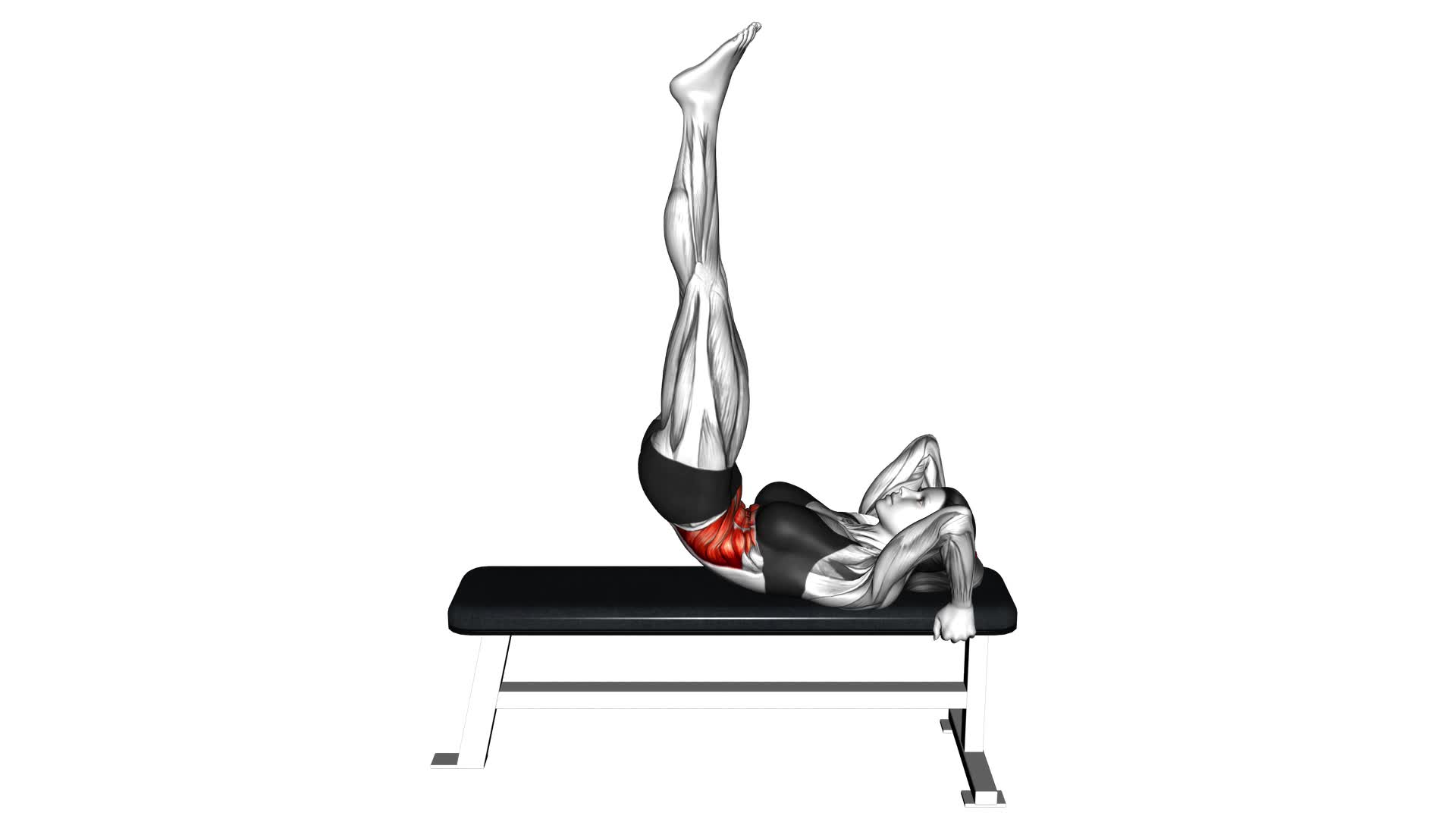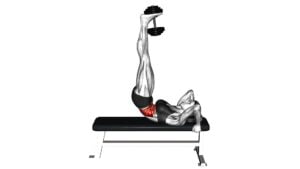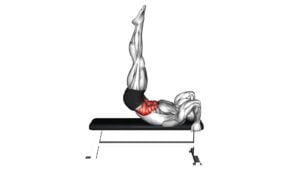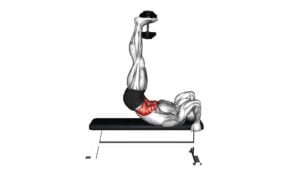Lying Flat Hip Raise (female) – Video Exercise Guide & Tips

Are you ready to tone and strengthen your glutes? Look no further than the lying flat hip raise!
Watch This Exercise Video
This exercise is perfect for targeting your lower body and building a strong, sculpted booty.
In this video exercise guide, we'll walk you through the proper form and technique, offer modifications for beginners, and show you some variations to spice up your workout.
Get ready to feel the burn and see amazing results with the lying flat hip raise.
Let's get started!
Key Takeaways
- Lying Flat Hip Raise targets core muscles, glutes, and hamstrings for improved core strength and lower body support.
- Equipment such as resistance bands, ankle weights, dumbbells, stability balls, and yoga blocks can be used to increase intensity and activate different muscle groups.
- Proper form and technique, such as keeping the back flat, engaging glutes and abdominal muscles, and maintaining proper body alignment, are essential for maximizing the effectiveness of the exercise.
- Modifications for beginners and variations to spice up the workout can be incorporated to suit individual fitness levels and goals.
Benefits of Lying Flat Hip Raise
Improve your core strength and stability by incorporating the lying flat hip raise into your workout routine. This exercise offers numerous benefits that can enhance your overall fitness.
One of the key advantages of the lying flat hip raise is that it targets your core muscles, including the abdominals, obliques, and lower back. By engaging these muscles, you can develop a strong and stable core, which is essential for good posture, balance, and preventing injuries.
Additionally, the lying flat hip raise helps to strengthen your glutes and hamstrings. These muscles play a crucial role in maintaining proper hip alignment and supporting your lower back. By strengthening them, you can improve your overall lower body strength and reduce the risk of lower back pain.
To increase the intensity of the lying flat hip raise, you can try a few variations. First, you can add resistance by placing a small dumbbell or weight plate on your hips. This will challenge your muscles further and help you progress in your strength training journey. Another option is to perform the exercise on an unstable surface, such as a stability ball. This will require more core activation and stability.
Incorporating the lying flat hip raise into your workout routine can provide numerous benefits, including improved core strength, stability, and lower body strength. By increasing the intensity of the exercise, you can further challenge your muscles and continue to progress in your fitness journey.
Equipment Needed for Lying Flat Hip Raise
To perform the lying flat hip raise, you'll need a mat or a comfortable surface to lie on. In addition to a mat, here are some exercise equipment and workout gear that can enhance your experience and help you get the most out of this exercise:
- Resistance bands: Adding resistance to your hip raises can increase the intensity of the exercise and provide a greater challenge for your muscles.
- Ankle weights: Strapping ankle weights onto your legs can add extra resistance and make the exercise more challenging.
- Dumbbells: Holding dumbbells in your hands while performing the hip raise can increase the workload on your glutes and hamstrings.
- Stability ball: Placing your feet on a stability ball instead of a flat surface can engage your core muscles even more and further challenge your balance.
- Yoga block: Placing a yoga block between your thighs can help activate your inner thigh muscles and promote proper alignment during the exercise.
These exercise equipment and workout gear options can help you take your lying flat hip raise to the next level. Now that you know what you need, let's move on to discussing the proper form and technique for this exercise.
Proper Form and Technique
To perform the lying flat hip raise with proper form and technique, it's important to focus on correct body alignment and engaging your core muscles.
Ensure that your back is flat against the ground and your legs are extended straight.
As you raise your hips, squeeze your glutes and engage your abdominal muscles for maximum effectiveness and stability.
Correct Body Alignment
Maintain proper body alignment throughout the lying flat hip raise exercise to maximize its effectiveness and prevent injury. To ensure correct body alignment, follow these guidelines:
- Position yourself lying flat on your back with your knees bent and feet flat on the ground.
- Engage your core muscles by gently drawing your navel towards your spine.
- Keep your spine neutral by avoiding excessive arching or rounding.
- Align your hips, knees, and ankles in a straight line.
- Avoid any excessive twisting or tilting of your pelvis.
By maintaining proper body alignment during the lying flat hip raise, you can improve your posture and reduce the risk of injury.
Correct alignment allows for optimal muscle activation and ensures that the targeted muscles are effectively engaged. Remember to listen to your body and make adjustments as needed to maintain proper form throughout the exercise.
Engaging Core Muscles
Engage your core muscles properly to ensure the correct form and technique during the lying flat hip raise exercise. Strengthening your abs and improving stability are essential for performing this exercise effectively.
To engage your core, start by lying flat on your back with your arms by your sides. Bend your knees and place your feet flat on the floor, hip-width apart.
As you lift your hips off the ground, focus on contracting your abdominal muscles. Imagine pulling your belly button towards your spine. Keep your core engaged throughout the entire movement, maintaining a neutral spine and avoiding any excessive arching.
This will help you target your abs, while also promoting better stability and overall body control.
Modifications for Beginners
Start with a few easier variations to gradually build strength and improve your form while doing the lying flat hip raise exercise. As a beginner, it's important to start with modifications that allow you to perform the exercise correctly without straining your muscles. Here are some beginner modifications and common mistakes to avoid:
- Partial Range of Motion: If you find it challenging to lift your hips all the way off the ground, start by lifting them halfway. This will still engage your glutes and core muscles while reducing the intensity.
- Bent Knee: Another modification is to perform the exercise with your knees bent. This decreases the leverage and makes it easier to lift your hips off the ground.
- Elevated Surface: If the exercise feels too difficult on the floor, try performing it on an elevated surface like a step or a bench. This reduces the range of motion and allows you to gradually progress.
- Supportive Band: Using a resistance band around your thighs can provide extra support and stability, making it easier to maintain proper form throughout the movement.
- Single Leg Variation: Once you feel comfortable with the basic hip raise, you can progress to a single-leg variation. Lift one leg off the ground while performing the exercise to challenge your muscles further.
Variations to Spice Up Your Workout
Looking to add some excitement to your workout routine? Try incorporating new workout moves and variations to enhance your exercise regimen.
By mixing up your fitness routine, you can challenge different muscle groups, prevent boredom, and achieve better overall results.
New Workout Moves
To spice up your workout routine, try incorporating new variations of workout moves. Adding variety to your workouts not only keeps things interesting, but it also challenges your body in different ways, helping you to continue making progress and avoiding plateaus.
Here are some new workout moves to try:
- Plyometric push-ups: These explosive push-ups help to improve power and upper body strength.
- Bulgarian split squats: By placing one foot behind you on a bench or step, you can target your glutes and quads in a different way.
- Medicine ball slams: This move engages your core and upper body while providing a great cardio workout.
- TRX rows: Using suspension straps, this exercise targets your back muscles and improves posture.
- Kettlebell swings: This dynamic movement works your glutes, hamstrings, and core while also increasing cardiovascular fitness.
Enhance Exercise Routine
To maximize the effectiveness of your workout routine and keep your fitness journey exciting, incorporate variations that enhance your exercise routine.
By adding different exercises and movements, you can enhance your overall fitness level and challenge your body in new ways.
One way to enhance your routine is by focusing on enhancing flexibility. Incorporate exercises like yoga or Pilates that stretch and lengthen your muscles, helping to improve flexibility and range of motion.
Another way to enhance your routine is by increasing strength. Incorporate strength-training exercises such as weightlifting or bodyweight exercises to challenge your muscles and build strength.
By incorporating these variations into your exercise routine, you can enhance your flexibility and increase your overall strength, taking your fitness journey to the next level.
Now, let's explore how to mix up your fitness regimen for even more exciting results.
Mix up Fitness Regimen
How can you add variety and excitement to your workout routine? Mixing up your fitness regimen is a great way to keep things fresh and prevent boredom. Not only does it make your workouts more enjoyable, but it also challenges your body in new ways, leading to better results.
Here are some ideas to help you mix up your exercises and optimize time management for workouts:
- Try different types of workouts, such as cardio, strength training, and flexibility exercises.
- Incorporate interval training or high-intensity workouts to increase intensity and burn more calories.
- Explore different fitness classes or join a sports team to make your workouts more social and fun.
- Use workout apps or online programs that provide a variety of exercises and routines.
- Create a workout schedule that includes different exercises each day to keep things interesting and prevent plateauing.
Tips for Getting the Most Out of Your Lying Flat Hip Raise
To maximize your results, focus on maintaining proper form and engaging your core muscles throughout the lying flat hip raise exercise. This will help you get the most out of this effective workout move.
First and foremost, it's important to pay attention to your breathing technique. Take a deep breath in as you lower your hips to the ground, and exhale as you raise your hips up towards the ceiling. This will help you maintain control and stability throughout the exercise.
In addition to correct breathing, there are a few common mistakes to avoid. One common mistake is arching your back too much during the movement. To prevent this, imagine pressing your lower back into the ground as you lift your hips. This will help you engage your core and prevent unnecessary strain on your lower back.
Another mistake to avoid is using momentum to lift your hips instead of relying on your core muscles. Remember to engage your abdominal muscles and use them to lift your hips, rather than relying solely on momentum. This will make the exercise more effective and help you target the right muscles.
Frequently Asked Questions
How Many Calories Does a Lying Flat Hip Raise Burn?
Lying flat hip raises are a great exercise for toning your lower body. However, they may not burn a significant number of calories on their own. They can still contribute to overall caloric burn and be effective when combined with other exercises in a well-rounded workout routine.
To maximize their effectiveness, focus on maintaining proper form and increasing the intensity by adding resistance or performing more repetitions.
Can Lying Flat Hip Raise Help in Reducing Belly Fat?
Lying flat hip raise can be a helpful exercise for reducing belly fat. However, there are other effective alternatives that can also target this area.
It's important to remember that spot reduction isn't possible, so incorporating a combination of exercises along with a healthy diet is key.
Lying flat hip raise not only helps in reducing belly fat, but it also strengthens and tones the overall body, making it a great addition to your fitness routine.
Is It Safe to Perform Lying Flat Hip Raises During Pregnancy?
During pregnancy, it's generally safe to perform lying flat hip raises. This exercise can help with pregnancy fitness by strengthening the core and pelvic floor muscles.
Lying flat hip raises can also provide benefits such as improved posture and reduced lower back pain. However, it's important to consult with your healthcare provider before starting any new exercise routine during pregnancy to ensure it's safe for you and your baby.
How Long Does It Take to See Results From Doing Lying Flat Hip Raises?
To see results from doing lying flat hip raises, it depends on various factors such as your current fitness level, diet, and consistency. However, with regular practice and proper form, you can start noticing improvements in your hip strength and stability within a few weeks.
Beginners can modify this exercise by starting with smaller hip raises and gradually increasing the range of motion. Incorporating lying flat hip raises into your workout routine can benefit you by strengthening your core, glutes, and hip flexors.
Can Lying Flat Hip Raises Improve Posture?
Lying flat hip raises can indeed improve your posture. By incorporating this exercise into your routine, you can strengthen the muscles in your core, lower back, and glutes, which are all essential for maintaining proper posture.
In addition, the movement involved in this exercise can also help increase flexibility in your hip flexors and lower back.
Conclusion
In conclusion, the lying flat hip raise is a highly effective exercise that targets the glutes, hamstrings, and core muscles. It can be performed with minimal equipment and can easily be modified for beginners.
By incorporating variations and following proper form, you can spice up your workout and maximize your results. Remember to focus on engaging the correct muscles and maintain a steady pace for the best outcome.
Keep pushing yourself and enjoy the benefits of this challenging exercise.

Author
Years ago, the spark of my life’s passion ignited in my mind the moment I stepped into the local gym for the first time. The inaugural bead of perspiration, the initial endeavor, the very first surge of endorphins, and a sense of pride that washed over me post-workout marked the beginning of my deep-seated interest in strength sports, fitness, and sports nutrition. This very curiosity blossomed rapidly into a profound fascination, propelling me to earn a Master’s degree in Physical Education from the Academy of Physical Education in Krakow, followed by a Sports Manager diploma from the Jagiellonian University. My journey of growth led me to gain more specialized qualifications, such as being a certified personal trainer with a focus on sports dietetics, a lifeguard, and an instructor for wellness and corrective gymnastics. Theoretical knowledge paired seamlessly with practical experience, reinforcing my belief that the transformation of individuals under my guidance was also a reflection of my personal growth. This belief holds true even today. Each day, I strive to push the boundaries and explore new realms. These realms gently elevate me to greater heights. The unique combination of passion for my field and the continuous quest for growth fuels my drive to break new ground.







